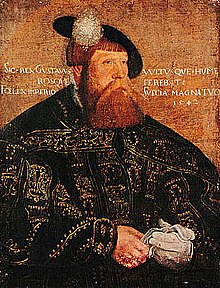House Wasa

The Wasa house was a Swedish royal family from 1521 to 1654 and a Polish royal family from 1587 to 1668. The symbol of the dynasty was a sheaf of wheat (Swedish: vase ).
history
The Swedish Wasa family provided Gustav Eriksson, later Gustav I. Wasa , after the separation from Denmark, the first king of Sweden after the Kalmar Union . This kingship became hereditary under Gustav Eriksson.
In the List of Kings of Sweden you can find this chronological list:
- Gustav I. Wasa , 1521-1560
- Erik XIV. , 1560-1568
- Johann III. , 1568-1592
- Sigismund (III. In Poland) , 1592–1599
- Charles IX , 1599-1611
- Gustav II Adolf , 1611–1632
- Christina I. , 1632-1654
Johann III. married Princess Katharina Jagiellonica of Poland and combined the Polish-Lithuanian royal house of the Jagiellonians with the Swedish. From him came the Polish line of the House of Wasa, which in turn can be found in the list of Polish rulers .
- Sigismund III. Wasa , 1587-1632
- Władysław IV. Wasa , 1632–1648
- John II Casimir , 1648–1668
With the childless Christina, the younger and better known Swedish line of the Wasa family also died out in the female line in 1689, after the male line had died out with Gustav II Adolf in 1632. The oldest line died out with Erik XIV's son Gustav in 1607. The middle line, which ascended the Polish throne with Johann's son Siegmund in 1587, but lost the Swedish throne in 1599, died out in 1672 with Johann II Casimir. The Palatinate-Zweibrücken- Kleeburg family, a branch of the Wittelsbach family , descendants of the Wasa family in the female line, now acquired the royal crown with Karl X Gustav in 1654. In Poland the decline began with John II Casimir, which from 1648 literally "flooded" the kingdom with calamity. Wars against the Ottoman Empire , Russia , Brandenburg-Prussia , Transylvania , Zaporozhian Cossacks and Sweden weakened the state considerably, socially, economically and politically. Domestically, the Liberum Veto against a parliamentary resolution was used for the first time in 1652 in the Polish Sejm . The Sejm could only pass resolutions unanimously, which in fact was no longer possible. In 1657 and 1660 the Duchy of Prussia was granted sovereignty, from which the Kingdom of Prussia later developed. The 1667 Andrussovo armistice with Russia cost huge areas. Cities like Smolensk and Kiev , as well as Ukraine up to the Dnepr , became Russian. Just a year later, after Johann Kasimir's abdication, another king (Prince Michael Wiśniowiecki ) ascended the Polish royal throne, not a Wasa, although Christina, now a Catholic, who had also abdicated (in Sweden), had plans for a time to be a candidate for the to put up the Polish royal election. The last male Wasa, Johann II Casimir, died in France in 1672 and left behind a war-torn, ruined country.
Descendants of the Wasas in the female line (first the Palatinate Wittelsbacher, later the Holstein-Gottorp dynasty ) ruled Sweden until 1818. The last princess, who called herself Princess von Wasa, was Queen Carola of Saxony (1833-1907), wife of the king Albert of Saxony and granddaughter of the Swedish king Gustav IV Adolf, who was dethroned in 1809 . But today's monarchs from the Bernadotte family also have a drop of Wasablut through Viktoria, nee. Princess of Baden , wife of Gustav V and great-grandmother of the current king, who descended in the female line from Gustav IV Adolf.
Other members of the family
- Anna Wasa († 1625), Princess of Sweden
- Ebba Eriksdotter Wasa (≈1491–1549), Swedish nobleman
- Johann Albert Wasa (Polish: Jan Olbracht Waza) (1612–1634), Prince of Poland
- Karl Ferdinand Wasa (Polish: Karol Ferdynand Waza) (1613–1655), Prince of Poland, Prince-Bishop of Breslau and Bishop of Płock
- Magnus Gustavsson Wasa (1542–1595), Swedish prince and duke of Östergötland
- Margaret Eriksdotter Wasa (1497–1536), Swedish nobleman and sister of King Gustav I of Sweden
Individual evidence
- ^ Meyers Konversationslexikon, 1890, Volume 16, p. 406
literature
- Günter Barudio : Gustav Adolf the Great. A political biography. Fischer, Frankfurt am Main 1982.
- Jörg-Peter Findeisen : The struggle for control of the Baltic Sea. Sweden's kings of great power times. Duncker and Humblot, Berlin 1992.
- Michael Roberts: The Early Vasas. Cambridge 1968.

